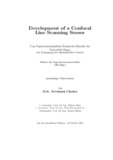Zitierlink:
https://nbn-resolving.org/urn:nbn:de:hbz:467-7131Dateien zu dieser Ressource:
| Datei | Beschreibung | Größe | Format | |
|---|---|---|---|---|
| chanbai.pdf | 9.93 MB | Adobe PDF |  Öffnen/Anzeigen |
| Dokumentart: | Doctoral Thesis | Titel: | Development of a confocal line scanning sensor Entwicklung eines konfokalen Zeilenscanners |
AutorInn(en): | Chanbai, Sirichanok | Institut: | Institut für Automatisierungstechnik | Schlagwörter: | Konfokal, Scheimpflug, Zeilenscanner, Rauheitsmessung, Optische Messtechnik, Confocal, Scheimpflug, optical measuring system, line scanner | DDC-Sachgruppe: | 620 Ingenieurwissenschaften und Maschinenbau | GHBS-Notation: | YBK | Erscheinungsjahr: | 2012 | Publikationsjahr: | 2013 | Zusammenfassung: | Surface characteristics are of vital importance for predicting the product life time and surface functionality, or even improving the manufacturing procedure. In consequence, this thesis focuses on the surface inspection using a non-contact technique. The principle of Confocal Microscopy(CM) enables light microscopes to gain depth information through what is known as depth discrimination ability. Among the other optical inspection techniques, the principle of confocal microscopy allows a parallel and motionless depth scanning scheme to be developed. The chromatic confocal point sensor is one prominent example of a parallel depth scanning scheme. However, this technique requires a separate analysis unit to analyze light of different wavelengths. The complication and relatively low efficiency of light per wavelength can pose a limit on developing a simplified configuration and a cost effective unit. Therefore, a novel approach to incorporate a tilted plane technique in a confocal imaging system is proposed in this thesis, namely a Confocal Line Scanning Sensor (CLSS). A parallel and motionless depth scanning scheme is then achieved with a cost-effective technique, resulting in a greatly simplified and robust configuration. This thesis is devoted to establish new knowledge on incorporating a tilted plane technique in a confocal imaging system. A novel approach to explain and to correct the variation of the magnification inherent in a tilted plane system, known as keystone distortion, is proposed. Moreover, particular data processing and calibrations are developed to support the new concept. Here, the Scheimpflug's principle is first applied with confocal microscopy, whereas selected well-known theories are also used to support the system design and construction. Finally, the experiments demonstrate that a tilted plane technique can successfully be incorporated in a confocal imaging system. In addition, the performance of the CLSS is evaluated through a series of experiments. Die Oberflächeneigenschaften eines Produktes sind genauso entscheidend für die Vorhersage der Produktlebensdauer und der Oberflächenfunktionalität wie für die Optimierung des Herstellungsprozesses. Daher befasst sich diese Arbeit mit der berührungslosen Oberflächenmesstechnik. Das Prinzip der Konfokalmikroskopie (CM) ermöglicht es dank seiner tiefendis-kriminierenden Eigenschaften mit Lichtmikroskopen Tiefeninformation zu erhalten. Die Konfokalmikroskopie erlaubt die Entwicklung einer parallelen statischen Tiefenabtastung ohne bewegte Teile. Chromatische-konfokale Punktsensoren sind ein bekanntes Beispiel hierfür. Sie benötigen jedoch ein separates Spektrometer zur Analyse der verschiedenen Wellenlängenanteile. Dessen komplexer Aufbau und die realtiv geringe Lichtausbeute je Wellenlänge macht es schwierig einfache und preiswerte Produkte zu entwickeln. Daher wird in dieser Arbeit ein neuer Ansatz unter Verwendung der Scheimp-flug-Technik in einem konfokalen Abbildungssystem, einen sogenannten konfokalen Zeilenscanner (CLSS), vorgestellt. Eine parallele statische Tiefenabtastung wird hier mit einer kostengünstigeren Technologie und einem robusteren Aufbau erreicht. Ein neuer Ansatz zur Erklärung und Korrektur der Vergrößerungsvariation, auch als Keystone-Verzeichnung bekannt, wird vorgestellt. Desweiteren werden Verfahren zur Datenauswertung und Kalibrierung entwickelt. Das Scheimpflug-Prinzip wird erstmals auf die Konfokalmikroskopie angewandt. Schließlich wird experimentell gezeigt, dass die Scheimpflugtechnik erfolgreich in einem Konfokalsystem eingesetzt werden kann. Die Eigenschaften des Verfahrens werden experimentell evaluiert. |
URN: | urn:nbn:de:hbz:467-7131 | URI: | https://dspace.ub.uni-siegen.de/handle/ubsi/713 | Lizenz: | https://dspace.ub.uni-siegen.de/static/license.txt |
| Enthalten in den Sammlungen: | Hochschulschriften |
Diese Ressource ist urheberrechtlich geschützt. |
Seitenansichten
462
checked on 04.04.2025
Download(s)
378
checked on 04.04.2025
Google ScholarTM
Prüfe
Alle Ressourcen in diesem Repository sind urheberrechtlich geschützt, soweit nicht anderweitig angezeigt.

